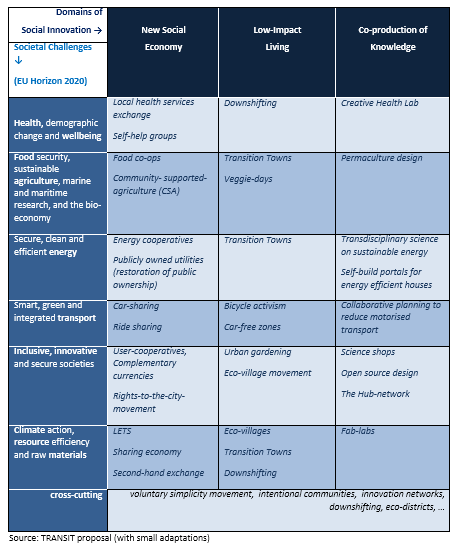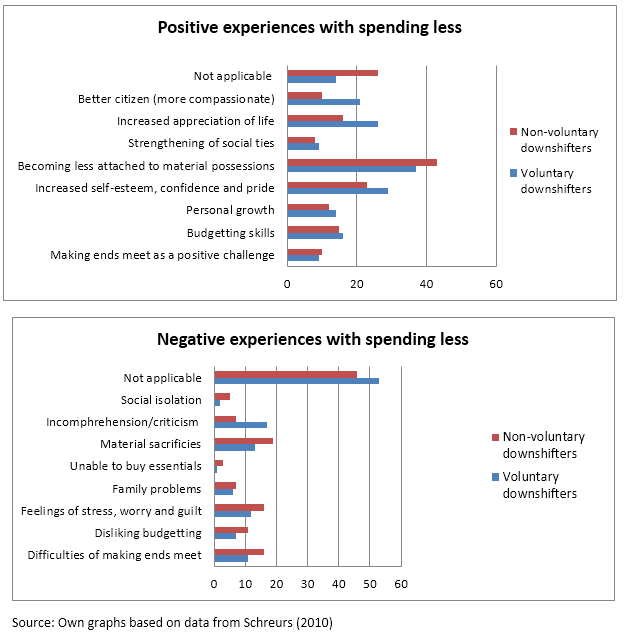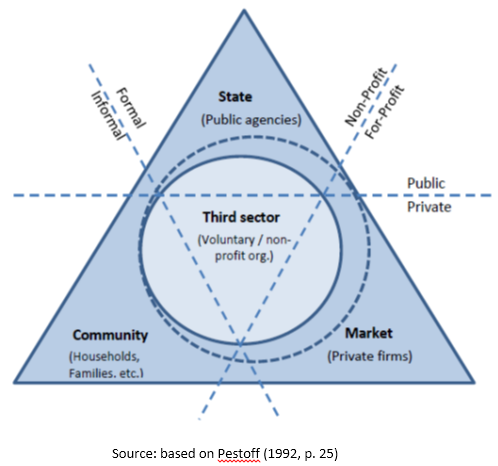By Rene Kemp.
Social innovation is found in the market economy, government and in society. This blog is about social innovation originating in the civil sector.
Civil sector social innovation consists of new social practices in which the practice – in terms of behaviour and social arrangement around it – itself is a primary motivational element instead of something secondary (to fulfil a functionalist need). Examples of social innovation are food co-ops, self-help portals, community supported forms of agriculture, social impact hubs and hacker spaces. Social innovation is difficult to categorise. An attempt at categorisation is given in the below table, showing that for each societal challenge there are social innovations in the domains of new social economy, low-impact living and co-production of knowledge. Some innovations are crosscutting in covering multiple domains. An example is intentional communities, where people live in a communal, low-impact way and openly talk about being good and responsible citizens.

All social innovations listed are relatively marginal in the sense that only a small proportion of society is involved in them. I suspect most people will think it to be small forever. This is certainly a possibility, but there is also another possibility, which is that they are part of an emerging social transformation the elements of which are described below. Whether or not they are something for a small minority of people, they are prompted by motivations that most people can personally relate to: to be an active member of society, to take part in social activities, to spend time with like-minded people, to reduce the environmental impact of one’s life, to care for others, and - in the case of downshifting - to have a better work-life balance.
Societal ills
In an article called “The New Normal”, Amitai Etzioni, Director of the Institute for Communitarian Policy Studies at The George Washington University (and former president of the American Sociological Association), presents evidence that the majority of Americans feel a certain dissatisfaction with a life centred on material consumption: “79% worried that society has become too shallow, 72% believed that society has grown intellectually lazy, while 85% said society has grown physically lazy. 60% worried that people have become too disconnected from the natural world. 57% want to be part of a truly important cause” (Etzioni, 2011, based on Euro RSCG Worldwide, 2010). Even more remarkably, “59% of Americans said they enjoyed saving money more than spending it, compared to 37% who enjoy spending money more than saving” (Newport, 2009) for the reason that “saving money made them feel good about themselves”. 79% of Americans respected or admired people who lived simply (with minimal purchases, no debt, etc.), while only 15% felt the same way about people who had high-luxury lifestyles (Euro RSCG Worldwide, 2010). 78% said that most of us would be better off if we lived more simply and 66% said they no longer want a lot of bells and whistles on the products they purchased; they would rather just have the functions they really needed” (Etzioni, 2011).
Research by Jeanine Schreurs into the effects of downshifting in the Netherlands revealed similar striking results. Many positive effects were reported, ranging from becoming less attached to material possessions, increased self-esteem, confidence and pride, to finding it a positive challenge to making ends meet. Reported negative effects were fewer in number and also less pronounced than the positive effects, even for the involuntary downshifters.

The results are striking and revealing but of their own probably will do very little in terms of convincing people to change their life. I also expect that most people will say that the above examples are not something for them. In the midst of a recession, saving money by cutting expenditures becomes a meaningful activity, which becomes less meaningful at a time of growing prosperity. But to have a sense of purpose in one’s life is universal. Becoming a better person is fostered by religion but hardly by schools, markets and the government. In schools children are being taught to reproduce knowledge rather than stimulated to be creative and caring persons. Most schools do little to boost the capacity for moral thinking of pupils and their capacity to be a happy person. In a recent book, William Deresiewicz typifies US university students who finished their education at an Ivy League university as excellent sheep: “students who are smart and talented and driven, but also anxious, timid, and lost, with little intellectual curiosity and stunted sense of purpose”.
If even the most smart and successful young people are lost, what about the rest of society? I am not saying that the whole of society feels lost but I do feel that each and every person wants to be more than a consumer. Everyone wants to be appreciated as a person, feel pride and dignity in what they do and this is something that cannot be bought in the market place. According to Michael Sandel in his book What money can’t buy, market values have crowded out nonmarket norms in almost every aspect of life, including personal relations.
One of the advantages of the social welfare system is that people get money when they are involuntary unemployed. People who are sick can obtain care via the health care system or from relatives and friends. But what if the social welfare and medical care systems become downsized (as they are likely to be)? Who will provide for care and support? In such a case voluntary work may serve a helping hand. Voluntarism has an old history. It is typically done on a one-to-one basis. The care receiver obtains care and help, but the care giver also gets something: gratitude and satisfaction from giving. If social innovation was to be based entirely on altruism and philanthropy it would not get far but it is based on various gains for those involved as the following three examples show.
Three examples
Voluntary work can be done via an organised system and one particular system is time banking. Time banking is a community-based means of exchange used to organise people and organisations around a purpose, where time is the principal currency. Tim does a task for Kate who does a task for Joe who does a task for Tim, etc. The "time" one spends providing a community service earns "time" that one can spend to receive services. In a time banking system, everyone’s time is equal, irrespective of the exchange. 1 hour of time = 1 hour of time credit. Examples of services include: child care, home repair, tutoring, language lessons, legal assistance, accounting, cooking.
Time banking offers the prospect of providing valued services such as elderly care, skills training of young out-of-work people and the long-term unemployed, integration of recent immigrants and the re-integration into society of offenders, substance abusers, and others who are otherwise often marginalised. In the UK, the departments of Justice and Defence are exploring the possibility of using time banks to re-integrate ex-offenders and ex-service men in society. Such a step will create challenges for time banks in terms of surveillance and possibly training. Time banking in the UK can be expected to grow thanks to social problems related to exclusion, poverty, inactive people who want to be active, the spread of time banks across the UK, professionalisation, new software allowing people to do services in a different vicinity, and perhaps most crucially, government agencies being interested in supporting it.
Critical elements for its acceptance and growth are the prevention of abuse and exploitation, maintaining trust, keeping members active, tax issues, every hour being valued equally (which works against the provision of highly valued services), criticism of unfair competition from commercial service companies who are losing clients, opposition from traditional volunteers and volunteering organisations.
Four scenarios are possible: 1) Time banking adheres to its roots of volunteering for social services and communitarianism, 2) Time banking becomes a vehicle for government social integration policies (and social welfare reform), 3) Time banking comes a central element of the local economy (with all kind of local businesses getting involved and TM becoming tied to a local currency), and 4) Time banking gets used for provision of care to individuals on a sustained basis which means that the quality and timely delivery of services has to be secured. Time bank members may need to be trained and coached, and their performance evaluated.
An altogether different approach to deal with social ills of exclusion and deprivation is offered by social entrepreneurs bringing a business mentality to social problems. This may be done on an individual basis or through a network such as Ashoka. With 3000 fellows in 70 countries, Ashoka is the largest worldwide network of social entrepreneurs. Its philosophy is to empower people to be active problem solvers. Ashoka provides a platform for those who want to enact social change by having new ideas and solutions to existing social problems. Ashoka fellows are nominated and selected in a lengthy and challenging procedure called “the venture process”. When selected, social entrepreneurs obtain support in the form of a stipend and services from other members (in the form of advice and access). Funding, comes from the Ashoka Support Network where each member provides at least 10,000 € a year for at least 3 years (flexible money), foundation partnerships, company partnerships (some of who provide pro bono advice), commercial spin-offs and other Ashoka branches (Germany passes 2.5 mln of its 4 mln € budget to other offices). Ashoka fellows aim for big social impact, which is the most important criterion for their selection. Example projects are pay-for-use toilets run by children, the setting up of fair trade schemes, and budget help for people in debt.
Ashoka sees itself serving a historical process, which is “the transformation of the citizen half of the world's operations from a pre-modern to the same entrepreneurial and competitive architecture that has driven business ahead over the last three centuries”. Past projects have been analysed to determine lessons for social impact multiplication and the lessons are shared internally and externally via social entrepreneurship courses. What motivates the entrepreneurs is to solve a problem in an entrepreneurial way. They see themselves as empowering or inspiring others: to become change makers too.
A third example is open science: “the movement to make scientific research, data and dissemination accessible to all levels of an inquiring society, amateur or professional. It encompasses practices such as publishing open research, campaigning for open access, encouraging scientists to practice open notebook science, and generally making it easier to publish and communicate scientific knowledge”. An example of open science is the internet-based course How to Change the World – by Michael S. Roth (Wesleyan University- USA) with the following weekly module.
Week 1 – What are Social Goods? From the Commons to Moral Revolutions
Week 2 – Poverty and Development
Week 3 – Climate Change and Sustainability
Week 4 – Disease and Global Health Care
Week 5 – Women, Education and Social Change Week 6 – Looking Back, Looking Forward
Students can join for free and earn a certificate. The aim of the course is to educate and inspire students and professionals towards social action. The idea for the course originally came out of The Social Good Summit in 2013. Courses like this one are surfacing around the world (some for free, others for money).
What connects the three examples is that they are all about empowering beneficiaries, helping people to become active in ways that befits one’s capabilities, becoming a better person, (re)gaining self-worth (for those who have lost this) and reduce dependencies. Not only do people become more active and socially integrated, there tends to be a larger role for judgment and autonomy in service provision. Care providers are empowered to give care in a way that they consider suited in each and every case. Services can be provided in a more customised way. Interestingly, social innovations are occurring everywhere: in care, food, energy, science, finance (credit unions, ethical banks), normal business (co-ops, corporate volunteering) and government. Some are reformist, others are radical.
In the TRANSIT project we seek to develop a theory of transformative social innovation, which inquires into big questions such as: What are the social innovation vehicles? What are the politics and foundational ideas behind it? Will the changes add up to a social transformation and will this transformation be for the better or also have a dark side?
The answers to these questions have to wait for a while. In a study for DEMOS called “The Third Way to a Good Society”, Amitai Etzioni offers a discussion of the politics of creating a good and better society, which he sees as lying in treating other people as ends (instead of as instruments for one’s own interest) and in instituting a moral culture into society through a fine-grained system of rights and responsibilities. An example of a duty is the obligation for high school scholars to do a community service as part of their civic practice. Likewise, those who receive welfare and cannot find gainful work could be asked to accept a community job. The above discussion of everyone becoming an active member of his and her community fits perfectly with the idea of Big Society embraced by the UK Conservative party, but, in the UK, Big Society is seen by critics of the government as an excuse for cutting public sector spending, which it partly is. On a more optimistic note, there is a widespread wish for society to become more cohesive through a greater sense of responsibility that is translated into action. The devolution of power to lower levels of governments, with local authorities being responsible for social integration, public services and local employment, will help to make people more active and resilient, but the realisation of a better world depends critically on social capital multiplication and empowerment, which cannot be steered from the top but has to grow in a bottom-up way. This is why social innovation of the kind discussed is so important.
In the decades to come, I see a social world developing in parallel to a not-so-social world. But as the social economy and open source models of design and knowledge are developing it becomes an orientation for people, who may decide to be part of this world rather than the other one. Developments in the not-so-social world (such as cutting on welfare expenditures and obligatory community work) may force people into the social world but this need not be such a bad thing if people can find a greater sense of self-worth. The social world can be expected to gain some political power of its own and thereby obtain favourable conditions.
Over time, the barriers imposed by markets and government can be expected to become more permeable, allowing social innovation-based change to enter also those domains, through hybrid forms (in terms of ownership, organisational motives, funding, cooperation in network structures). In TRANSIT we investigate the generative mechanisms of social innovation and conditions for growth and transformative change. The conditions for growth are likely having to do with government resourcing and reform of welfare sectors, social organisations becoming more like businesses (for instance, by charging for services), grant organisations changing their funding models, societal duties for young people and recipients of social welfare and rights for marginalised people to be active citizens. The process will depend on political choices but these choices are partly endogenous to the process, as in earlier transformations.

References and further readings
Avelino, F. (2009) "Empowerment and the challenge of applying transition management to ongoing projects", Policy Sciences, 42(4):369-390
Avelino, F. Wittmayer, J., Haxeltine, A., Kemp, R., O’Riordan, T., Weaver, P., Loorbach, D. and Rotmans, J. (2014) Game-changers and Transformative Social Innovation. The Case of the Economic Crisis and the New Economy, [TRANSIT working paper]
Etzioni, A, (2011) The new normal, Sociological Forum, 26 (4), pp. 779-789.
Etzioni, A. (2000) The Third Way to a Good Society, report for DEMOS.
Haxeltine, A., Wittmayer, J., Avelino, F., Kemp, R., Weaver, P., Backhaus, J., and O'Riordan, T. (2013) Transformative social innovations: A sustainability transition perspective on social innovation, Paper presented at the international conference Social Frontiers : The next edge of social innovation research, at GCU's London Campus on 14th and 15th November 2013.
Pestoff, V. (1992) “Third Sector and Co-Operative Services – An Alternative to Privatization”, Journal of Consumer Policy, 15 (1), pp.21-45.
Sandel, M. (2012) What money can’t buy. The Moral Limits of Markets, Penguin.
Schreurs, J. (2010) Living with Less: Prospects for Sustainability. PhD thesis Maastricht University.
Thomas, K.W. and Velthouse, B.A. (1990) “Cognitive Elements of Empowerment: An “Interpretive” Model of Intrinsic Task Motivation”, Academy of Management Review, 15(4): 666-681
Stay informed. Subscribe for project updates by e-mail.